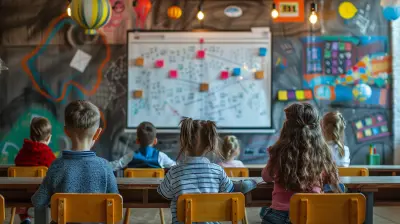How to Create Lesson Plans that Encourage Independent Learning
4 November 2025
Let’s be real for a second—teaching ain't easy. And creating lesson plans that encourage independent learning? That’s like trying to teach a cat to fetch. Possible, but it takes finesse. You want your students to rise like academic phoenixes, right? Confident, curious, and capable of flying on their own? Well, you’re in the right place.
This is your guide to making lesson plans that don't just spoon-feed info but make students grab the spoon, fill it themselves, and maybe even steal the whole pot (in a good way, of course).
🚀 What Does Independent Learning Even Mean?
Before we dive into the deep end, let’s float around in our arm floaties and define what we're talking about.Independent learning is when students take the wheel of their own education. They plan, they manage, they problem-solve. Basically, they turn from passive learners into academic MacGyvers. Your job? Hand them the metaphorical duct tape and paperclips.
It doesn’t mean you're out of the picture. Nope. You're still there—like a GPS voice—calmly rerouting them when they take an educational wrong turn.
🧠 Why Should You Even Bother?
Let’s not sugarcoat this—it takes effort to design these kinds of lesson plans. So why invest the time?- Critical Thinking: Students become less “repeat after me” and more “let me figure this out.”
- Self-Motivation: They stop asking, “Is this on the test?” and start asking, “How can I apply this?”
- Life Skills: Because let’s face it, you can’t hand-hold them forever. Unless you’re planning to follow them to college. Please don’t.
Sold? Awesome. Let’s get planning.
🔧 Step-by-Step: Building Independence into Your Lesson Plans
1. Start with the End in Mind (Thanks, Stephen Covey)
Ask yourself: What does success look like? If you want students to research, analyze, and reflect on their own—then your lesson plan better not be 90% lecture and 10% worksheet.Instead, start with a clear independent-learning goal. For example:
🚫 “SWBAT understand cell division”
✅ “SWBAT create a visual model explaining each stage of mitosis using peer-reviewed sources”
See the difference? One tells them “here’s the info,” the other whispers, “go find it, young grasshopper.”
2. Provide the Skeleton, Let Them Add the Meat
Think of your lesson plan like a taco shell. Your job is the shell. The students? They fill it with knowledge, hot sauce, and a side of insight.Break down your content into:
- Essential questions: Big, juicy curiosity-provoking ones. Like, “How does climate change affect communities differently across the world?”
- Must-know concepts: Don't overload them; keep it tight.
- Optional deep dives: Give them the freedom to nerd out if they want to take it further.
Let students choose how they demonstrate their learning—presentations, models, digital projects, even interpretive dance (yes, really).
3. Choice is the Spice of Learning
Ever ordered from a menu with too many options and had a full-blown existential crisis? Yeah, you don’t want to do that to your students. But giving them some choice? That’s chef's kiss.Add choice boards, project menus, or “pick two out of three” assignments. Let them decide:
- What topic to explore
- What medium to express it in
- Whether they work alone or with a buddy
This makes them feel responsible for their learning. Like choosing your own adventure, minus the dragons (unless it’s a history lesson on medieval warfare).
4. Build in Time for Reflection (No, Really—Don’t Skip This)
Reflection isn't just for yoga class. It’s where the magic happens. When students reflect, they process what they’ve learned and how they learned it.Try:
- Journals (paper or digital)
- Exit tickets with a twist: “What’s one thing you learned your way today?”
- Peer reviews or self-assessments
These moments help them connect the dots and realize, “Hey, I figured this out myself!” That’s the sweet spot.
5. Use Scaffolding Like an Educational IKEA Manual
Okay, listen: giving students freedom doesn’t mean tossing them into the deep end and yelling “Swim!” That’s how you end up with chaos and paper airplanes.Scaffolding is your BFF. Think of it like building furniture with just enough instructions to help but not do it all for them. (And hopefully fewer Allen wrenches.)
Start with:
- Guided questions
- Mini-lessons on tricky skills (cite those sources, kids!)
- Templates or models, then slowly remove them as confidence grows
Fade into the background like a proud mentor.
6. Group Work: When 1 Brain Isn’t Enough
Group work gets a bad rap—mostly because someone always gets stuck doing everything while another kid videos a TikTok dance. Let’s fix that.Structure groups with roles and responsibilities tied to project goals. Rotate them. Hold mini-meetings for check-ins.
Teach them how to collaborate, not just assume they know. Think of it like giving them teamwork training wheels.
7. Use Tech Tools That Empower, Not Distract
We’re living in the golden age of educational tech. But instead of burying your lessons under a pile of flashy apps, stick to tools that support independent exploration.A few rockstars:
- Padlet: For brainstorming and resource sharing
- Flip: To express understanding through video
- Google Classroom + Docs: For collaborative writing and self-paced guides
- Kahoot Challenges: Spice up review with solo quiz battles
Make tech the sidekick, not the superhero.
8. Feedback That Fuels Rather Than Frustrates
Let’s ditch the red pen massacre. Feedback should be helpful, not hurtful—and definitely not confusing.Try this cycle:
1. Self-assess
2. Get peer feedback
3. Revise
4. Then get your feedback
Make it ongoing, not a one-shot deal. Feedback becomes something students use to grow instead of something they dread seeing in the margins.
9. Normalize Struggle (Yes, Struggle = Good)
Here’s a spicy truth: independence means making mistakes. Lots of them.Be open about the learning process. Share times you struggled to understand something. Heck, do a live demo of how you research something you don’t know. Take the pressure off perfection.
Call mistakes “data,” not “failures.” Because if Google Maps can recalculate, so can your students.
10. Celebrate the Big and the Small Wins
Finally, throw a little confetti. Encourage students to shout, “I did it my way!” (cue Sinatra). Celebrate effort, not just outcomes.Use:
- Student showcases
- Learning portfolios
- Independent Study Highlights on a bulletin board or class website
Make them feel like the scholars they’re becoming.
🧪 Sample Lesson Plan Structure (Don’t Worry, You Can Customize)
Here’s a plug-and-play format to get you started:Topic: Renewable Energy Sources
Objective: Students will research and present on a renewable energy source of their choice, demonstrating understanding of its pros, cons, and global impact.Hook: Show a short video of extreme weather caused by climate change. Ask: “Can energy choices change this future?”
Mini-Lesson: Research skills and source evaluation.
Independent Task:
- Pick one energy source (solar, wind, geothermal, etc.)
- Research using library and assigned databases
- Create a presentation (video, infographic, podcast—your call)
Checkpoints:
- Day 1: Topic + initial research
- Day 2: Outline and source check
- Day 3: Peer feedback on rough draft
- Day 4: Final presentation
Reflection: Exit slip—“What was most challenging and how did you overcome it?”
Mic drop. 🎤
🧩 Common Pitfalls to Avoid
Just to save you from stepping in the puddles I’ve already danced in:- Don’t assume students know how to be independent. Teach them.
- Don’t over-control. Back off slowly.
- Don’t skip structure. Freedom needs boundaries.
- Don’t mistake “busy” for “learning.” Reflection and purpose matter.
💡 Final Thoughts
Creating lesson plans that encourage independent learning doesn’t mean giving up control—it means shifting it. You become less of a lecturer and more of a learning coach. A mentor. The Gandalf to their Frodo.Sure, it takes patience and trust, but when your students start owning their learning, you’ll see the most magical thing of all happen in your classroom—growth. Not just academically, but in confidence, curiosity, and capability.
And hey, that’s something worth planning for.
all images in this post were generated using AI tools
Category:
Lesson PlansAuthor:

Eva Barker

